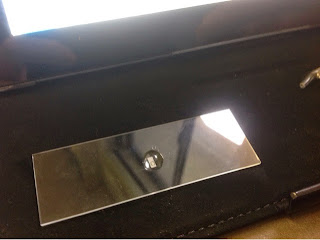Objective:
Materials:
- 50 mL beaker
- 10 mL and 50 mL graduated cylinder
- Catalase solution
- Filter paper punches
- Hole stopper
- Stop Watch (iPad)
- Reaction chamber
- Tweezers
- Tub of water
To begin, we took the vial of catalase solution and carefully dipped a filter paper punch in it using tweezers. We then stuck the soaked paper to the top, inside wall of the chamber. Next, we added 10 mL of 3% hydrogen peroxide into the chamber, making sure it didn't touch the filter paper. If it had touched the filter paper, it would start to react, and ruin the experiment.


We then put in the stopper and placed the entire contraption into the water. Next, we filled the cylinder with water by laying it horizontally and letting the air bubbles out and carefully tilted it into a vertical position, making sure the water stayed in it. Then for a whopping ten minutes, we held the graduated cylinder above the chamber to catch the released oxygen, making sure to switch places when our arms began to cramp. Now for the science behind it! Hydrogen Peroxide naturally decomposes when exposed to light in this reaction: 2 H202 -> 2 H20 + 02. The rate of this decomposition changes due to factors such as temperature, concentration, and pH. Sadly, we only were able to experiment with concentration. Hydrogen Peroxide begins to decompose when exposed to sunlight because the light provides enough energy to exceed the required activation energy and begin the reaction. This is why Hydrogen Peroxide is kept in dark, opaque containers to prevent the decomposition from commencing. Catalase speeds up the decomposition by finding a way to orientate the hydrogen peroxide molecule in a way that the oxygen can be freed more easily. Back to our experiment. Using the scale on the side of the graduated cylinder, we measured the amount of oxygen produced every 30 seconds. The results were nearly linear! We repeated the same steps with 2 and 4 paper punches. Our results are below:


We then put in the stopper and placed the entire contraption into the water. Next, we filled the cylinder with water by laying it horizontally and letting the air bubbles out and carefully tilted it into a vertical position, making sure the water stayed in it. Then for a whopping ten minutes, we held the graduated cylinder above the chamber to catch the released oxygen, making sure to switch places when our arms began to cramp. Now for the science behind it! Hydrogen Peroxide naturally decomposes when exposed to light in this reaction: 2 H202 -> 2 H20 + 02. The rate of this decomposition changes due to factors such as temperature, concentration, and pH. Sadly, we only were able to experiment with concentration. Hydrogen Peroxide begins to decompose when exposed to sunlight because the light provides enough energy to exceed the required activation energy and begin the reaction. This is why Hydrogen Peroxide is kept in dark, opaque containers to prevent the decomposition from commencing. Catalase speeds up the decomposition by finding a way to orientate the hydrogen peroxide molecule in a way that the oxygen can be freed more easily. Back to our experiment. Using the scale on the side of the graduated cylinder, we measured the amount of oxygen produced every 30 seconds. The results were nearly linear! We repeated the same steps with 2 and 4 paper punches. Our results are below:
Sadly, we were short on time, so we weren't able to do 3 paper punches and could only do 5 minutes of the 4 paper punches. Looking back at our data, we concluded that each paper punch of catalase sped the reaction time up by about 3 times. This was a little surprising because one would assume having two instead of one would only be twice as fast if the rate is related to the surface area of the paper punch or the total volume of the Catalase. Therefore, there must be another factor that we don't yet understand.













